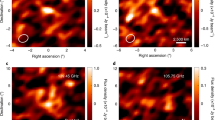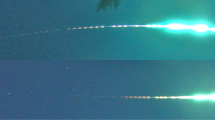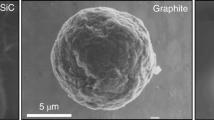Abstract
Interplanetary dust particles are important samples of dust-producing objects in the Solar System, including many primitive and organic-rich bodies that are not sampled by known meteorites. Interplanetary dust particles spiral in towards the Sun under the influence of Poynting–Robertson drag forces and are exposed to solar energetic particles that leave tracks of ionization damage in anhydrous silicate grains. Here we determine the exposure ages of track-rich interplanetary dust particles using a new calibration of the solar energetic particle track production rate and show that track-rich interplanetary dust particles have long exposure ages (>1 Myr) that preclude an origin from main-belt asteroids and Jupiter-family comets. We propose that track-rich interplanetary dust particles represent samples of dust produced by collisions among Edgeworth–Kuiper belt objects and that appreciable amounts of Edgeworth–Kuiper belt object dust contribute to the zodiacal cloud. Many track-rich interplanetary dust particles also contain abundant secondary minerals that provide direct evidence for past aqueous activity on some Edgeworth–Kuiper belt objects.
This is a preview of subscription content, access via your institution
Access options
Access Nature and 54 other Nature Portfolio journals
Get Nature+, our best-value online-access subscription
$29.99 / 30 days
cancel any time
Subscribe to this journal
Receive 12 digital issues and online access to articles
$119.00 per year
only $9.92 per issue
Buy this article
- Purchase on Springer Link
- Instant access to full article PDF
Prices may be subject to local taxes which are calculated during checkout


Similar content being viewed by others
Data availability
The data are provided in the article and the Supplementary Information.
References
Busemann, H. et al. Ultra-primitive interplanetary dust particles from the comet 26P/Grigg–Skjellerup dust stream collection. Earth Planet. Sci. Lett. 288, 44–57 (2009).
Thomas, K. L., Blanford, G. E., Keller, L. P., Klöck, W. & McKay, D. S. Carbon abundance and silicate mineralogy of anhydrous interplanetary dust particles. Geochim. Cosmochim. Acta 57, 1551–1556 (1993).
Messenger, S. Identification of molecular cloud material in interplanetary dust particles. Nature 404, 968–971 (2000).
Fraundorf, P., Flynn, G. J., Shirck, J. & Walker, R. M. Interplanetary dust collected in the earth’s stratosphere—the question of solar flare tracks. In Proc. 11th Lunar Science Conference (ed. Merrill, R. B.) 1235–1249 (Pergamon, 1980).
Bradley, J. P., Brownlee, D. E. & Fraundorf, P. Discovery of nuclear tracks in interplanetary dust. Science 226, 1432–1434 (1984).
Christoffersen, R. & Buseck, P. R. Mineralogy of interplanetary dust particles from the ‘olivine’ infrared class. Earth Planet. Sci. Lett. 78, 53–66 (1986).
Crozaz, G. & Walker, R. M. Solar particle tracks in glass from the Surveyor 3 spacecraft. Science 171, 1237–1239 (1971).
Blanford, G. E., Fruland, R. M. & Morrison, D. A. Long-term differential energy spectrum for solar-flare iron-group particles. In Proc. Sixth Lunar and Planetary Science Conference (ed. Merrill, R. B.) 3557–3576 (Pergamon, 1975).
Keller, L. P., Berger, E. L., Zhang, S. & Christoffersen, R. Solar energetic particle tracks in lunar samples: a transmission electron microscope calibration and implications for lunar space weathering. Meteorit. Planet. Sci. 56, 1685–1707 (2021).
Nesvorný, D. et al. Cometary origin of the zodiacal cloud and carbonaceous micrometeorites. Implications for hot debris disks. Astrophys. J. 713, 816–836 (2010).
Poppe, A. R. An improved model for interplanetary dust fluxes in the outer Solar System. Icarus 264, 369–386 (2016).
Koschny, D. et al. Interplanetary dust, meteoroids, meteors and meteorites. Space Sci. Rev. 215, 34–96. (2019).
Liou, J.-C., Zook, H. A. & Dermott, S. F. Orbital evolution of micron-sized dust grains coming from the Kuiper Belt (abstract). Lunar Planet. Sci. Conf. 26, 853–854 (1995).
Flynn G. J. in Physics, Chemistry and Dynamics of Interplanetary Dust (eds Gustafson, B. A. S. & Hanner, M. S.) 171–175 (Astronomical Society of the Pacific Conference Series Vol. 104, 1996).
Moro-Martín, A. & Malhotra, R. A study of the dynamics of dust from the Kuiper Belt: spatial distribution and spectral energy distribution. Astron. J. 124, 2305–2321 (2002).
Sandford, S. A. Solar flare track densities in interplanetary dust particles: the determination of an asteroidal versus cometary source of the zodiacal dust cloud. Icarus 68, 377–394 (1986).
He, H.-Q., Zhou, G. & Wan, W. Propagation of solar energetic particles in three-dimensional interplanetary magnetic fields: radial dependence of peak intensities. Astrophys. J. 842, 71 (2017).
Shestopalov, D. I., Golubeva, L. F. & Cloutis, E. A. Optical maturation of asteroid surfaces. Icarus 225, 781–793 (2013).
Vernazza, P., Binzel, R. P., Rossi, A., Fulchignoni, M. & Birlan, M. Solar wind as the origin of rapid reddening of asteroid surfaces. Nature 458, 993–995 (2009).
Keller, L. P. & Berger, E. L. Transmission electron microscopy of plagioclase-rich Itokawa grains: space weathering effects and solar flare track exposure ages. In Hayabusa 2017: Symposium of Solar System Materials, Sagamihara, Japan, Astromaterials Science Research Group/Japan Aerospace Exploration Agency (2017).
Keller, L. P. & Berger, E. L. Solar energetic particle tracks in Itokawa samples: implications for regolith development on near-Earth asteroids and space weathering. In 84th Annual Meeting of the Meteoritical Society, Lunar and Planetary Institute Contribution No. 2609 abstr. 6111 (2021).
Noguchi, T. et al. Space weathered rims found on the surfaces of the Itokawa dust particles. Meteorit. Planet. Sci. 49, 188–214 (2014).
Poppe, A. R. et al. Constraining the Solar System’s debris disk with in situ New Horizons measurements from the Edgeworth–Kuiper belt. Astrophys. J. Lett. 881, L12–20 (2019).
Liou, J.-C. & Zook, H. A. Kuiper Belt dust grains as a source of interplanetary dust particles. Icarus 124, 429–440 (1996).
Grün, E. et al. Discovery of Jovian dust streams and interstellar grains by the Ulysses spacecraft. Nature 362, 428–430 (1993).
Flynn, G. J. & Sutton, S. R. Cosmic dust particle densities: evidence for two populations of stony micrometeorites. In Proc. 21st Lunar and Planetary Science Conference, Lunar and Planetary Institute, Houston, 541–547 (1991).
Mukai, T., Ishimoto, H., Kozasa, T., Blum, J. & Greenberg, J. M. Radiation pressure forces of fluffy porous grains. Astron. Astrophys. 262, 315–320 (1992).
Webber, W. R. & Lockwood, J. A. Heliocentric radial intensity profiles of galactic cosmic rays measured by the IMP, Voyager, and Pioneer spacecraft in solar 11-year modulation cycles of opposite magnetic polarity. J. Geophys. Res. 109, A11101 (2004).
Bonino, G. et al. Solar and galactic cosmic-ray records of the Fermo (H) chondrite regolith breccia. Meteorit. Planet. Sci. 36, 831–839 (2001).
Snead, C. J., McKeegan, K. D., Keller, L. P. & Messenger, S. Ion probe measurements of comet dust and implications for models of oxygen isotope heterogeneity in the Solar System. In 48th Lunar and Planetary Science Conference, Lunar and Planetary Institute Contribution No. 1964 abstr. 2623 (2017).
de Bergh, C., Boehnhardt, H., Barucci, M. A., Lazzarin, M. & Fornasier, S. Aqueous altered silicates at the surface of two plutinos? Astron. Astrophys. 416, 791–798 (2004).
Jewitt, D. From comets to asteroids: when hairy stars go bald. Earth Moon Planets 72, 185–201 (1996).
Matzel, J. E. P. et al. Constraints on the formation age of cometary material from the NASA Stardust mission. Science 328, 483–486 (2010).
Ogliore, R. C. et al. Incorporation of a late-forming chondrule into comet Wild 2. Astrophys. J. Lett. 745, L19 (2012).
Nakashima, D. et al. Late formation of a comet Wild 2 crystalline silicate particle, Pyxie, inferred from Al–Mg chronology of plagioclase. Earth Planet. Sci. Lett. 410, 54–61 (2015).
Nakamura-Messenger, K., Messenger, S., Clemett, S. & Keller, L. P. Aqueous alteration in comets. Meteorit. Planet. Sci. 46, 843–856 (2011).
Keller, L. P., Thomas, K. L. & McKay, D. S. Carbon abundances, major element chemistry and mineralogy of hydrated interplanetary dust particles. In XXIV Lunar and Planetary Science Conference, Lunar and Planetary Institute, Houston 785–786 (1993).
Keller, L. P. et al. The nature of molecular cloud material in interplanetary dust. Geochim. Cosmochim. Acta 68, 2577–2589 (2004).
Wyatt, S. P. & Whipple, F. L. The Poynting–Robertson effect on meteor orbits. Astrophys. J. 111, 134–141 (1950).
Takaki, N. et al. Resurfacing processes constrained by crater distribution on Ryugu. Icarus 377, 114911 (2022).
Nakamura, T. et al. Early history of Ryugu’s parent asteroid: evidence from return sample. In 53rd Lunar and Planetary Science Conference, Lunar and Planetary Institute, Houston 1753 (2022).
Dermott, S. F., Durda, D. D., Grogan, K. & Kehoe, T. J. J. in Asteroidal Dust in Asteroids III (eds Bottke, W. F. Jr et al.) 423–442 (Univ. Arizona Press, 2002).
Acknowledgements
We thank CAPTEM and the JSC Astromaterials Curation Facility for allocating the IDP samples used in this study. The electron microscopy was performed in the Electron Beam Analysis Labs at the NASA Johnson Space Center. This work was supported in part by the Johnson Space Center Coordinated Analysis Work Package to L.P.K. funded by the NASA Internal Scientist Funding Model, and grant NNX19AE59G from the NASA Emerging Worlds programme to G.J.F.
Author information
Authors and Affiliations
Contributions
L.P.K. measured track densities and wrote parts of the manuscript, G.J.F. preformed the track density calculations and wrote parts of the manuscript.
Corresponding author
Ethics declarations
Competing interests
The authors declare no competing interests.
Peer review
Peer review information
Nature Astronomy thanks Andrew Poppe and the other, anonymous, reviewer(s) for their contribution to the peer review of this work.
Additional information
Publisher’s note Springer Nature remains neutral with regard to jurisdictional claims in published maps and institutional affiliations.
Supplementary information
Supplementary Information
Supplementary text and Figs. 1–27.
Rights and permissions
About this article
Cite this article
Keller, L.P., Flynn, G.J. Evidence for a significant Kuiper belt dust contribution to the zodiacal cloud. Nat Astron 6, 731–735 (2022). https://doi.org/10.1038/s41550-022-01647-6
Received:
Accepted:
Published:
Issue Date:
DOI: https://doi.org/10.1038/s41550-022-01647-6



